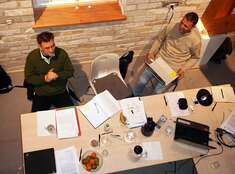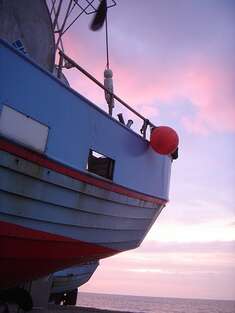Coastal cultures
- Coastal Cultures in Times of Change
- Background Text for the Field Trip
- Background Literature for the Symposium
Coastal Cultures in Times of Change
From 24th till 27th of November 2010 the symposium "Coastal cultures in times of change" was held in Slettestrand, Denmark.
People fight for their coastal culture
In a former fishing community in Northern Denmark, a range of researchers met in cold and snowy November weather to discuss how European coastal communities are changing. All along the European coastline the story is well known. Fishing activities, the former main activity for the communities, is disappearing as an occupation, and focus shifts towards industry and in later years towards tourism and cultural heritage as the new income provider. But the European consumers still eat fish, and with the proper management fishing could still be an integral part of coastal communities and in coastal culture. To do this a focus on quality and new regional products would be needed. Instead, all over Europe states and the EU implements a narrow management perspective on boat lengths and quota sizes and the overall political aim of economic efficient and rational fisheries. The consequence, it was argued, is that we create a business that no one wants to work in, harbours that no one wants to visit, boats that have no regional characteristics and that we destroy that coastal culture that makes tourism possible today. The symposium circled around a number of deep paradoxes in the management of coastal areas. Most fisheries policies and rural development policies have political aims of securing development and well-management of both economic, social and ecological resources, but it seems most of them also have a real hard time to implement these goals. From reform to reform, the problems seem to deteriorate, and the demands on the reforms become even bigger. Another paradox is the focus on development through tourism and cultural heritage on one hand and the reforms that centralizes and reduces the fleet on the other hand. The fishing activities in the harbour are, as well as the material existence of boats and gear the foundation of the cultural heritage and of immense value for tourism. But in order to produce an efficient and rational fishery, scrapping reforms are introduced a long with transferable quota systems that concentrate fishing rights on a few bigger boats. The symposium also revealed that in spite of many similarities across Europe, there are also many differences. The ecological base differs quite radically between the Mediterranean and the North Sea, and this has consequences for the management system, fishing activities and the social organization. It was clear however, that all over the continent people fight to maintain their coastal culture and a decent everyday life.
Theme
The coastal regions of Europe are areas under pressure and undergoing rapid change. From disappearing occupations in fishing and industry, to a growing focus on tourism and cultural heritage, the coastline of Europe is under transformation.
At the conference "Coastal cultures in times of change" we wished to challenge the present view on the development of coastal and rural areas mainly dominated by tourism and the development of an cultural economy. What if we viewed fishing not as a thing of the past, but as a central element in the future development of coastal communities? How can a focus on quality and new products pave the way forward for fishing communities? In which ways are European communities influenced by the common fisheries policies made in the European Union? Is there a distinct European development? Can new reforms and organizational setups help consolidate the coastal communities on basis of their special cultural heritage?
The purpose of the conference was to gain wide knowledge about European coastal regions and the challenges they face today, and to discuss how fishing activities and lifemodes (can) still shape the cultural landscape of coastal communities and harbours. The conference had a special focus on the ongoing reform of the Common Fisheries Policy and how this process is involving and influencing everyday lives in European coastal communities.
Besides the symposium there was a guided field excursion in order to explore the region and see different Danish fishing communities.
Background Text for the Field Trip
From Hanstholm to Thorupstrand: common past, different futures
Written by Mathilde Højrup, 2010.
Before 1967 there was no big difference between Hanstholm and Thorupstrand. In both places there was near-shore fishery with small boats that landed on the beaches. But in 1967 the port of Hanstholm was constructed, and this caused the big difference between the two fisheries we see today. With the new port Hanstholm became a much bigger city, and boats from the surrounding communities began to use the new port instead of their own beaches. This caused the end of a lot of landing places, but in Thorupstrand as well as a few other places fishers stayed and landed on the beach as they had done for a thousand years. Hanstholm, on the other side, developed in to one of the biggest fishing harbours in Denmark with a total of 4,5 km of quays.
Fishing port of Europe
The port of Hanstholm was build as a fishing port but it also became a port with ferries sailing to Norway, Iceland, the Faroe Islands and Shetland Islands. Compared to other ports in Denmark, Hanstholm have some advantage: it is (like Thorupstrand) close to Norway and to the best North Sea fishing grounds, and it has the largest fish auction with fresh high quality e-fish (from among others Thorupstrand). After 1967 the port was enlarged in 1977 and again in 1987 and in 2010 there was made a new vision for the port of Hanstholm.
“The development plan sets out the following visions:
• Port of Hanstholm, Denmark’s leading fishing port, is to become Europe’s leading fishing port
• Port of Hanstholm will continue its strong focus on traceability and food safety
• Port of Hanstholm will exploit its location to become an important transit port for cargo between Europe, Scandinavia and the Gulf of Bothnia
• Hanstholm will become a ferry port with connections to the Faroe Islands, Iceland, Norway and Scotland
• Hanstholm will become a ‘zero-energy port’
• Port of Hanstholm will become a centre for wave energy
The new piers will ensure unique sailing conditions for all types of vessels, and, finally, the closing of the existing port entry will give the fishing port exceptional conditions, as it will be separated from the port’s other activities and have calm waters all year round. So, already in five years time, Port of Hanstholm will have achieved its aim of becoming one of the leading ports in Denmark and Europe.”
Thorupstrand
When the port of Hanstholm was build a general expectation was, that all the boats that landed at the beaches near Hanstholm eventually would start fishing from the port of Hanstholm and therefore it was only a matter of time before the small landing places would disappear. This also happened to a lot of the near landing places. But Thorupstrand among others did not disappear and kept being an important landing place. There are a lot of things that make it more valuable for the Thorupstrand fishers to stay in Thorupstrand rather than moving to Hanstholm and using the port. There will always be the great value in fishing and living in the same place as your family has done in generations, but first of all there is a pride in fishing from Thorupstrand. No matter whether you own a boat or just work on one in Thorupstrand you get an equal percentage of the catch of the boat, the fishery is share organized. While there like in Hanstholm is strong competition between the fishers, the fishers fishing from Thorupstrand are also very dependent on each other, without a certain amount of boats and fishers it would be impossible to maintain the landing place and its facilities. Where in Hanstholm the ice factory, the packing department ect. are all private individual businesses, that are there to earn money, in Thorupstrand the winch, the ice factory, the packing department and the cleaning of fish house are there only for the fishers of Thorupstrand. All these services are organized in a cooperative which is owned by all the fishing families of Thorupstrand. And more importantly the people working in the packing department in Thorupstrand earn percentages of the income from the gathered catch of Thorupstrand, they are not wageworkers, this is also share organized. Therefore the three men working in the packing room are also the three men in the board of the packing department. 11 percentage of each boat’s catch goes to the packing department and the winch. The fishers of Thorupstrand are also together in the fishermen’s association and the wholesale society. The lifeboat station is owned by the state, but it is only people working in the fishery of Thorupstrand that are in the board of the lifeboat station and that form the rescue team.
Privatization and quota speculation
In 2007 the Danish government went through with the privatization of the (demersal) fishing industry. Quotas shares were allocated to the boat owners, and the amount of quotas were defined on basis of the vessels last three years of catch. Already in 2005 this was decided and fishers in Hanstholm started buying boats from different ports in Denmark, they bought them cheap, because the owners, the local fishers, had no idea that their boat soon would be worth an amount of quotas too. Fishers in Hanstholm started buying boats two years before the privatization began and therefore earned a lot of money on this. Other fishers who had fought against the idea of privatization were one or two years behind fishers in Hanstholm when it came to buying boats. From 2006 to 2008 the prices of the boats rose 1000 per cent, and fishers in Hanstholm gained a lot on the boats they had bought, and with that in hand they were able to lend even more money in the banks and continue to buy boats. This was a very good situation for Hanstholm, which made it possible for the fishermen’s association in Hanstholm to create a pool for quotas, where those in Denmark who wanted to rent out or just rent quotas could become members. In this way Hanstholm became a center for quota renting in the North Sea, Skagerrak and the Baltic Sea. This of course only happened on the cost of other ports in Denmark. But the financial crisis hit Hanstholm too, and now it seems that some of the big fishers in Hanstholm will choose to sell their boats and quotas to Sweden, where a even bigger company is planning to buy as many quotas as possible from Denmark. In Thorupstrand, because of the privatization, which had meant the end of all the other landing places, twenty families joined together and created the Thorupstrand guild of Inshore Fisheries – a quota company that bought quota for all the members guild in Thorupstrand.
Background Literature for the Symposium
Coastal cultures

Coastal cultures

